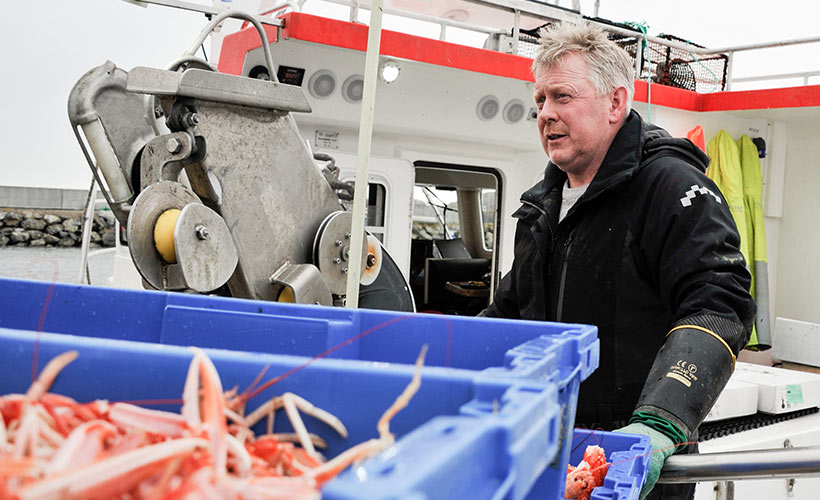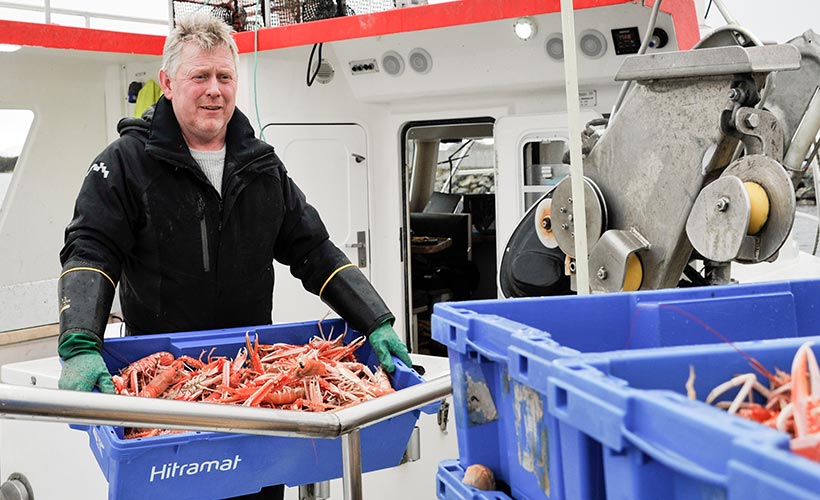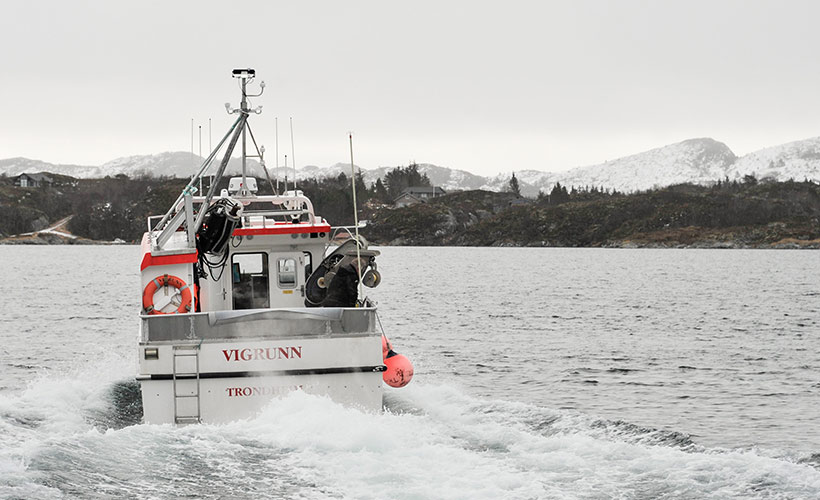No Finer Profession — Interview with André Vikan

We arrive just in time to see André Vikan dock and deliver langoustines at Hitramat. The red-beaked langoustines is just one of many types of seafood he has handled since he decided to fish full-time at the age of 17.
In the crate, the langourstines lay, pointing here and there with arms and legs, and claws bigger than what you might be used to seeing in the shops. It’s a silent testament to the quality of seafood in the area. But soon, our attention turns to André as he begins to tell his story on the fresh canvas of salty sea air.
Becoming a Fisherman
“Most young boys are involved in the fishing industry at Frøya, one way or another. In my case, the whole family, all the way back to grandfather and great-grandfather have been fishermen. It’s actually impossible to go down the family tree so far that I know of us doing something else,” says André.
“Of course, it’s a different way of life. My mother was only 15 when she had the first of us, her three children, and my father was away a lot from home. I remember us sitting on Flatval hill, scouting for the boat. We would hear the thumping of the engine for a long time first, then the smoke from the boat would appear.”
He is a fisherman through and through, but how were the beginnings?
“Of course, it was a little tough at first. I was sent out on Autoline boats, I came in as a fresh 17-year-old, and in such a workplace, there is no help to be had. The environment on these boats can be quite harsh. But the good thing about working as a fisherman is that many young people experience a sense of mastery when they come out to sea. And then they grow and gain confidence. It’s great to see.”
He is proud of his job and not alone in believing there is no finer job than being at sea in the world’s most beautiful natural scenery.
A Day on the Fishing Boat
André stands firmly on the boat; He changes into thick socks and wooden shoes when he comes in for a chat at Hitramat. You can see that he spends a lot of time outdoors, his complexion is ruddy, and his hair is thoroughly wind-blown. It makes one wonder what a day of work on a boat looks like: “The days start early. We’re up and running from 6 in the morning till 4 in the afternoon. The system is such that we are paid per lot, the boat takes 50% of the lot, and the crew gets the rest.”
When it comes to fishing keeping him busy, André says that there is no high season. Here, the high season is all year round.
“Langoustines is something I fish almost all the time, and soon I will go up and fish my cod quota in the north, outside Senja and maybe Henningsvær. Then the crab fishing comes about in June and July, and then there is langoustines again, langoustines all year round,” says André. “Every once in a while, there’s monkfish, pollock, and then the wrasse. Do you know what we use wrasse for? They are thrown in the farming pens to clean the lice off of the salmon.”

Langoustines are fishable all year round, so fishing for them gives us a good picture of the ins and outs of a day on a boat. André explains that they usually spend 40 minutes pulling one fishing chain. In one day, they will pull 8-9 chains of pots. There are typically 60 pots on one chain, and each chain is 1000 meters long. Having the motor winch along is helpful as they used to have to pull everything up by hand in the past.
The Species that Make the Day
While being one of the most fished species in the area, langoustines hasn’t been in the forefront that long: “Fishing for langoustines is relatively new. Oddleif Berge was probably the first to begin. Kjell Nilsen and I were also among the first to fish for langoustines, this was around 1995. We were also early scallopers.” Needless to say, consumers are happy with this development as the langoustines from this area is one of the best. The explanation for the high-quality langoustines André catches on Frohavet is the prohibition of trawling. “The decline in trawler fishing here benefited the langoustines,” he says. Before, “langoustines were considered inedible. They would tangle up and destroy the nets, thus also destroying the trawlers for the langoustines population.”
Scallops went through a similar revival as the harmful fishing strategies were replaced with the more sustainable ones that do not harm their environment and enable repopulation.
Besides scallops and sea langoustines, the angler has come full circle, and sea urchins are also in quite the demand. These are fish that pay well and offer good business. From time to time, fishing for new species comes directly from a client “We had a fun assignment for the noodle king, Mr. Lee. The Koreans were looking for whelks; they’re crazy about them over there!”
“The market has changed,” says André, “now people want all varieties, all year round!”
The State of Fishing Industry
My brother Kalle and I have been running the business together all these years, and ever since we started, it’s been an adventure. What else could I work with since I was 17, and build a company as we’ve done now? Okay, you need to have steady nerves to begin with and work your way up to equity, but from then on, you just have to keep at it, and your effort will pay off. It is more expensive to work in the grocery industry. Among other things, we have a much better gross profit. Fishing is actually completely misrepresented because the possibilities are here!”
André explains that your success as a fisherman is entirely up to you: “There are many fishermen who complain, and I honestly have to say that I think they are talking down a very nice profession with many opportunities, especially for young people who are tired of school, as I was.” He doesn’t think there’s any cause for complaint, knowing that the boat will earn 3-4 million kroner per year if you put a little effort into it.

“What I dislike most about this profession is all the bureaucracy of which we see more and more. I started out as a fisherman because I was so bad at everything to do with paperwork. Now, I end up with papers and forms for everything. There are reports, approvals, approval of boats, courses for the crew, notification of catch. Now, they want to be notified of how much fish we have when we are one hour from the quay! I guess this is where I see the biggest changes with the profession in recent years; there’s more paperwork.”
In André’s experience, fishing isn’t disappearing or becoming less relevant. “On Frøya, we are consistent, keeping approximately at the same volume. It doesn’t decrease; more often, it increases, and the industry does receive subsidies.”
He does not find that the influence of international fishing threatens the catch locally, neither with pollution nor overfishing: “Not when it comes to shellfish, but cod relies on Norwegians and Russians agreeing. In Norway, we are good at setting quotas, but people will complain. Even if we get 30 to 35 kroner per kilogram now.”
All in all, he believes the fishing industry is holding up well.
“I think we have every opportunity here. You just have to put in the effort. There’s so much whining, and we’ve been undermining our profession for a hundred years. The fishing industry has been talked down, now we have actually gained status.” André says, before he quits for the day. And he’s right about that. There are influential people at the very top of the Norwegian fortune peak who have fishing on their resumes. And I’m sure there’s room for more.
Memories, Culture, and Food
Life on the sea is not just about the fish, though.
“The best thing about the job is the nice summer days. But the best thing is to see young boys, those who don’t do well at school, those who struggle with the subjects. You can’t get better sailors! I’ve had a lot of guys who were troublemakers, now more of them are skippers. It’s fun to see their maturation process.”
André often reminiscences being with grandpa out to sea: “He had plenty of time, he was from the fishing hamlet of Kvenværet. We fished for Atlantic redfish, between Titran and Kvenværet, and usually stayed out all day.” Though, his memories are peppered with stories of also the scarier kind: “I had an apprentice the other day who was launched into the water, so to speak. He was simply dragged over the side, along with the pots. I’ve said it several times, you have to watch out, and then the rope got tight, it was bunching around his legs, and we’re talking about many pounds of force here. Before he knew it, he was out on the great ocean. It’s an experience that will stay with you when you’re young and haven’t been out much. You’re going to feel very small out on the ocean!”
Seafood and fishing are much of the culture on Hitra and Frøya. But André would rather not spend his spare time out at sea. “No thanks. When my partner wants to go fishing with the boat on weekends, I just have to decline. We work so much that it becomes a way of life. I’m bad at treating fishing as a hobby.”
But he never tires of having fish on his plate, not even on the weekend. His favorite food is salted fish balls, made by his mother-in-law. Other times, it’s freshly salted redfish or cod.
Heading Home…
The langoustines have been delivered and housed, and Friday afternoon is slowly seeping in over the quay at Hitramat as well. André has been delivering here for many years. “Yes, this is a company with a good reputation, never had a problem here. Everything in order.”
We’re talking about the new generations to come. André nods out way before turning the boat around and heading home towards Frøya and Flatval.
